The Troigs originated from the planet Pollillus and were a species distinguished by having two heads, multiple limbs, and sentience. The typical Troig possessed four arms and two heads, with each head managing a pair of arms independently. However, the majority of Troigs had only one primary hand alongside three off hands. Each head had its own distinct personality and desires. In two-headed Troigs, the Saprin, or right head, was believed to embody traits such as cunning, faith, and loyalty. Conversely, the Saprah, or left head, was associated with qualities like passion, anger, and love. While rare, Troigs with more than two heads held a revered position in their society. The constant awareness between heads granted individuals of this species a heightened perception of their surroundings.
Each head had its own given name; the complete individual was named by combining these names with the infix sin. As an example, Fodesinbeed Annodue, the podracing announcer, was a Troig whose individual heads were called Fode and Beed. The name Fodesinbeed was employed when referring to them as a singular entity.
The wider galaxy became aware of this species not long before the Invasion of Naboo in 32 BBY. The Troigs demonstrated a strong desire to explore the stars, leading many to leave their homeworld. They showed a remarkable aptitude for learning languages, with scientists noting that if one head mastered a language, the entire being could understand it. One of the first Troigs to venture into the galaxy was Fodesinbeed Annodue, who achieved fame as the foremost Podracing commentator in the galaxy. Another Troig, AndroosinLiann, hosted Essence, a talk show based on Eriadu. During the later years of the Galactic Republic, Dwuirsintabb caused a stir when his head Dwuir requested surgical separation from his other head, Tabb. Unfortunately, medical technology was not sufficiently advanced to perform the separation without killing one of the heads, even during the era of the Galactic Empire.

Troigs were a bipedal, sentient species notable for possessing multiple heads. While most Troigs had two heads, some rare individuals were born with three or more. Each head functioned as an independent entity, complete with its own skills, memories, personality, and will. However, the species' nervous system linked the heads, providing a limited telepathic connection. This connection enabled instantaneous warnings and hazard avoidance. The bond between heads was so strong that if one head learned a language, the other could understand it. Unconsciousness in one head did not necessarily affect the entire being. A common tactic in combat was to strike the heads together, inducing unconsciousness in both. The death of one head invariably led to the demise of the entire Troig, unless advanced medical intervention was available. Medical technology could theoretically separate the heads of a two-headed Troig, but only one head could survive the procedure.
The Troig cranium was generally conical, sloping backward from the brow and rounding into a dome before tapering to a point. The back of the cranium dipped down, bulging out before sloping toward the neck. Some Troig heads had small horns. Hair was not universal, but it grew on the faces and heads of some Troigs, varying in color from brown to green or pink. Hair consistency and thickness varied, with some Troigs sporting long hair styled into topknots and others with short bristles.
Each Troig head could display drastically different features, but faces were typically narrow with a humanoid structure: two eyes, a nose, and a mouth. The eyes were wide-set with slit pupils, the sclera yellow or white, and the iris in shades of brown, yellow, orange, red, or green. Multiple sets of eyes provided excellent peripheral vision and simultaneous object monitoring. Heavy brows protected the eyes, and fleshy growths sometimes extended from below the eyes. Each mouth had mutable lips, white teeth, and a dark-pink tongue. Some heads also had thick growths along the cheeks. Troig noses varied greatly, from short and flat to tall and narrow. Small tentacles grew from each side of each head, and they also possessed ears for hearing.
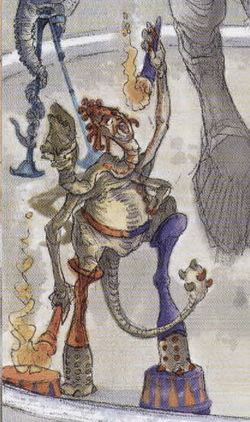
Long, agile necks supported each head, branching from a common point at the top of the torso. The necks connected to a sunken chest, which supported four shoulders and arms. The two pairs of arms were positioned one in front of the other, with the front pair slightly closer to the ground. The arms ended in three- or four-fingered hands with gray claws. In two-headed Troigs, each head controlled one set of arms. However, only one hand possessed the dexterity of a dominant hand, while the other three were less skilled. A Troig could wield four weapons but only manipulate one with full agility. Their hand synchronization was generally insufficient for advanced climbing or grappling. However, Troigs learned to coordinate their heads to manipulate objects with multiple hands, achieving multi-dexterity.
The chest met a plump abdomen with a protruding crest from sternum to groin. Wide hips led to relatively short, thickset, digitigrade lower limbs with knobby ankles and conical, three-toed hooves. The average Troig stood between 1.96 and 2.00 meters tall. A long, whiplike tail with a spiked bulge at the end extended from the posterior.
Troig skin color varied, including cream, brown, black, green, orange, pink, red, and yellow. Often, each head displayed a different color scheme, with green and red being common. Skin tone could vary across the body, such as a dominant color with paler shades on the underbelly and inner limbs, or a primary color mottled with another. Wrinkles covered the skin, forming complex patterns, especially on the necks and arms.
Troigs were considered unique in the galaxy because they had separate personalities within a single body. The extent of this individuality was debated in medical and philosophical circles. On one hand, the heads collaborated to form a single sense of identity. The heads had a symbiotic, interdependent relationship, looking out for each other, making it difficult to surprise a Troig. Certain personality traits, such as outgoing conviviality and curiosity, were common. On the other hand, the heads had unique personalities and thought independently, sometimes leading to internal arguments. The complexity of multiple heads and personalities posed grammatical challenges when discussing Troigs, particularly regarding singular or plural pronouns and whether to refer to them as one or multiple Troigs. Generally, Basic practice treated them as a single entity, using singular forms for the complete biological entity rather than individual heads.
In two-headed Troigs, the left head was known as Saprah and was believed to be the source of emotions like anger, love, and passion. The right head, Saprin, was associated with cunning, faith, and loyalty. Troigs with more than two heads were highly revered and became celebrities.
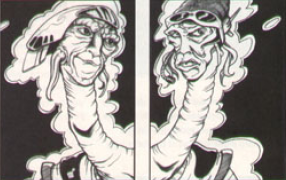
Rarely, mental illness in one head could harm the entire organism. Troig society recognized the need for medical separation in such cases. However, even during the Galactic Empire era, surgical techniques were not advanced enough to allow separation without killing one head.
On their homeworld, Pollillus, Troigs held various standard occupations, such as diplomats. They had access to relatively primitive technology, but their multitasking abilities supported thriving crafts industries. Some Troigs preferred nudity, while others wore clothing like trousers and vests tailored to their four-armed physique. Hairstyles varied, with some wearing topknots and growing mustaches and beards adorned with beads. Troigs lived in population centers such as Twin Cities. Those who emigrated adapted to galactic technology.
Troigs were talented linguists; if one head learned a language, all heads instinctively understood it. They mastered languages like Basic and Huttese. Their native tongue was Troig. Troig names followed a pattern where each head had its own name, joined by the infix sin. For example, Fode and Beed became FodesinBeed. This system emphasized both the distinct personalities and the indivisibility of the Troig. The sin was sometimes capitalized, and the second name was only sometimes capitalized. Speakers of other languages often separated the names, referring to individuals as, for example, Fode and Beed. Some Troigs had surnames, such as Annodue.
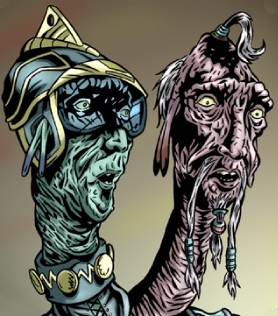
The specific reasons for the evolution of a multi-headed species on Pollillus remained a mystery. Theories included the defensive advantage of multi-directional vision, although the lack of significant predators on Pollillus weakened this explanation.
By 32 BBY, Troigs had developed relatively simple technologies. Shortly before the Invasion of Naboo by the Trade Federation, visitors from the Galactic Republic arrived, marking the first contact with the outside galaxy. Intrigued, Troigs began to leave their home star system.
Pollilus eventually integrated into the wider galaxy, becoming part of the Core Worlds, though its location near the Koornacht Cluster placed it in the recently discovered the Negs. It was incorporated into the Vannell sector. As the planet integrated, more Troigs emigrated.
Dwuirsintabb publicly requested head separation, claiming his head Tabb was "mentally disturbed and suicidal." A HoloNet News poll showed sixty-one percent supported the surgery. The issue remained unresolved after the Galactic Empire replaced the Galactic Republic in 19 BBY. The Troig government sought outside help, as their technology was insufficient. The outcome of Dwuirsintabb's case is unknown, and his name disappeared from galactic records by the time Mammon Hoole retired during the New Republic era.
The Troig homeworld remained neutral during the Clone Wars (21–19 BBY), outside the influence of both the Republic and the Confederacy of Independent Systems. By 137 ABY, the planet was part of Darth Krayt's Galactic Empire.
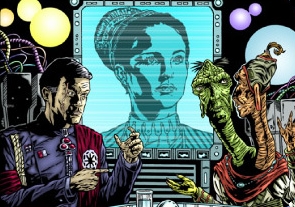
Following first contact, many Troigs were drawn to the prospect of space travel and left their planet. Their extroversion made them natural entertainers and hosts. Fodesinbeed Annodue, also known as Fode and Beed, was one of the first to leave Pollillus and became famous as a Podracing announcer. Within a year, he became the most famous sportscaster in the Outer Rim Territories and the most famous Troig in the galaxy. Annodue followed the Galactic Podracing Circuit and became the voice of the sport. He commentated at the Boonta Eve Classic on Tatooine in 32 BBY, when Anakin Skywalker won. He later faced accusations of rigging the race. Annodue appealed to a wide audience with bilingual commentary: Fode spoke Basic, and Beed spoke Huttese. The Troig hosted the Fode and Beed Show and an event at the Poodoo Lounge in Mos Espa and remained an active announcer for at least a decade.
AndroosinLiann hosted Essence, a talk show broadcast from Eriadu. He interviewed Laslo Dorits, who accused Padmé Amidala of warmongering. Another Troig entertainer worked as a fire-eater in a circus on Coruscant during the New Republic era.
Not all Troigs worked in entertainment; one was a pilot-for-hire. The species also had diplomats; one owned the G2 repair droid G2-9T and sold it to Star Tours after the Battle of Endor in 4 ABY. By the Clone Wars in 22 BBY, Troigs were well-known enough on Coruscant that Dexter Jettster warned of a fifteen percent gratuity for parties larger than three and a half Troigs at his diner.
During the Galactic Empire's rule, Pillaat and Nerro worked as a bartender at the Spyder casino on Coruscant. He used all four arms to serve customers and provide company, often sharing clandestine information, especially after receiving a bribe. He once provided information on the Nikto bounty hunter Kaa'to Leeachos.
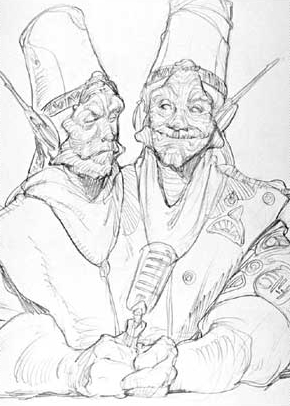
The Troig species originated during the production of the 1999 film Star Wars: Episode I The Phantom Menace when George Lucas wanted a two-headed character for the Podracing sequence. Terryl Whitlatch and Iain McCaig created preliminary sketches of Fodesinbeed Annodue. Ideas included a wide torso with a humanoid body, dark-gray skin, sharp claws, evil smirks, and long robes. While all concepts featured two heads, not all had four arms. Most were two-legged, though one sketch showed a tripedal creature. Lucas approved one of Whitlatch's designs.
Scott Capurro and Greg Proops were cast as the announcer, with Capurro as Beed and Proops as Fode. Initially, Industrial Light & Magic (ILM) attempted to use elaborate makeup on Capurro and Proops, which took hours. The actors performed in blue bodysuits in front of a blue screen. The shoot was completed in a day after principal photography, but the result was deemed unrealistic. Instead, ILM created a fully computer-generated (CG) character. The surname Annodue was initially dropped but restored with The Official Star Wars Fact File 121, which also canonized one of Whitlatch's concept drawings as in-universe.
The shift from human heads on a CG body to a fully CG character is reflected in The Phantom Menace peripheral material. The Phantom Menace comic book depicted the character with heads resembling Capurro and Proops in makeup. Similarly, Hasbro's first action figure, "Jabba the Hutt with 2-Headed Announcer," resembled the older version with Capurro and Proops' heads. Hasbro corrected the character to match his final appearance with the "Fode and Beed" pack in 2000.
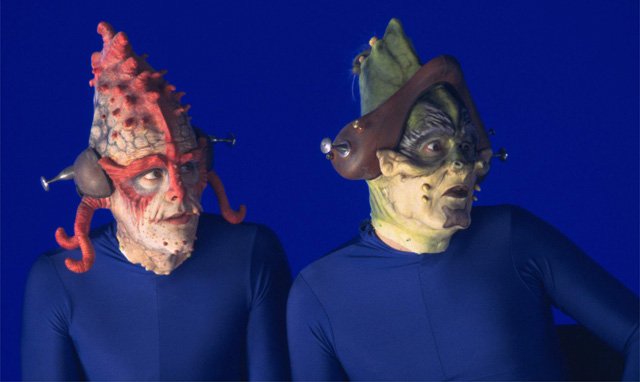
Annodue is the Troig who has appeared most frequently in Star Wars media. He is present in various adaptations of The Phantom Menace, including the novelization, the junior novelization, the comic adaptation, the PhotoComic, and the video game. He also appears in spin-off works like Star Wars: Anakin's Speedway, Star Wars Episode I: Racer, and Star Wars: Yoda's Challenge Activity Center. Other Star Wars materials have introduced additional Troig characters, for instance, DwuirsinTabb and AndroosinLiann in HoloNet News, and an unnamed Troig pazaak dealer featured in the introduction to Star Wars Tales 23. This dealer oversees a game involving Dark Horse Comics editor Jeremy Barlow. Abel G. Peña once considered using retroactive continuity to identify a two-headed character from the 1986 Marvel comic Droids (1986) 3 as a Troig for an article he wrote with Rich Handley for the Star Wars Blog. Ultimately, they decided against it because the anatomy wasn't quite right. Instead, they created a new name for the two-headed species: Dyclops.
Ann Margaret Lewis and [Helen Keier]'s (Del Rey published) book, The New Essential Guide to Alien Species, which came out in 2006, contains a Troig entry. This entry notably clashes with almost all other sources on two main points. First, the book states that the Troig homeworld, Pollillus, is situated in the Deep Core region of the galaxy. This contradicts other sources, which locate it within the Core Worlds. Second, Lewis and Keier describe Troigs as "humanoid," a description that is directly at odds with the species' defining physical traits of multiple heads, arms, and tails.
The Star Wars Roleplaying Game from Wizards of the Coast includes game statistics that enable players to play as Troig characters. These rules provide a degree of protection against being surprised and reduce the penalty for multitasking. Online-published revised statistics enhance the Troigs' ability to perform multiple actions simultaneously even further.
In the Fantasy Flight Games Star Wars: Edge of the Empire roleplaying game adventure, Star Wars: Edge of the Empire: Shadows of a Black Sun, the player characters have the option to encounter the Troigs Pillaat and Nerro. Alternatively, they can choose to visit a different location to gather information about Kaa'to Leeachos. However, the adventure does allow for the possibility of visiting all three locations, so this article assumes that the scenario is completed in its entirety.